Sources
- Gregorovius, Ferdinand. Rome in the Middle Ages Vol. IV Part 1. 1905.
Leo de Benedicto Christiano, or just Benedictus Christianus, was a Jew of Trastevere in the late eleventh century. He converted to Christianity and was baptised by Pope Leo IX, whence he took his Christian name. He related himself to the ancient patrician families of Rome by the marrying of his daughters to powerful suitors. He himself was extremely rich (probably from usury).
In January 1058, as a partisan of the newly elected Pope Nicholas II, Leo had the gates of the Leonine City thrown open for Godfrey, former duke of Lower Lorraine, and his wife, Beatrice, marchioness of Tuscany. Godfrey immediately possessed the Tiber Island and attacked the Lateran, forcing Benedict X to flee on 24 January. Leo allied himself with the reformers, including Hildebrand and Pope Alexander II, but he was unable to dispel, through negotiations, the attack of 14 April 1062 which gave Rome to Antipope Honorius II.
His son was Pier Leoni and through him he is the father of the great Pierleoni family which dominated Roman politics for much of the Middle Ages. So far as one can tell, he lived in peace with the Roman people and the pontiff, but his grandson, who was elevated to the papacy as Antipope Anacletus II, was lambasted for his Hebrew ancestry; as was another grandson, Jordan, who was elected patrician of the Commune of Rome and became also an enemy of the legitimate popes.
An antipope is a person who makes a significant and substantial attempt to occupy the position of Bishop of Rome and leader of the Catholic Church in opposition to the legitimately elected pope. At times between the 3rd and mid-15th centuries, antipopes were supported by important factions within the Church itself and by secular rulers.

Pope Benedict V was the pope and ruler of the Papal States from 22 May to 23 June 964, in opposition to Leo VIII. He was overthrown by Emperor Otto I. His brief pontificate occurred at the end of a period known as the Saeculum obscurum.

Antipope Boniface VII, otherwise known as Franco Ferrucci, was a Catholic prelate who claimed the Holy See in 974 and from 984 until 985. A popular tumult compelled him to flee to Constantinople in 974; he carried off a vast treasure, and returned in 984 and removed Pope John XIV (983–984) from office. He is supposed to have put Pope Benedict VI to death. After a brief second rule, he died under suspicious circumstances. He is today considered an antipope.
Pope Gregory V, born Bruno of Carinthia, was the bishop of Rome and ruler of the Papal States from 3 May 996 to his death. A member of the Salian dynasty, he was made pope by his cousin, Emperor Otto III.
Pope Sylvester III, born John in Rome, was Bishop of Rome and hence ruler of the Papal States from 20 January to March 1045.
Pope Stephen IX was the head of the Catholic Church and ruler of the Papal States from 3 August 1057 to his death in 29 March 1058. He was a member of the Ardenne-Verdun family, who ruled the Duchy of Lorraine, and started his ecclesiastical career as a canon in Liège. He was invited to Rome by Pope Leo IX, who made him chancellor in 1051 and one of three legates to Constantinople in 1054. The failure of their negotiations with Patriarch Michael I Cerularius of Constantinople and Archbishop Leo of Ohrid led to the permanent East–West Schism. He continued as chancellor to the next pope, Victor II, and was elected abbot of the Benedictine monastery of Montecassino.
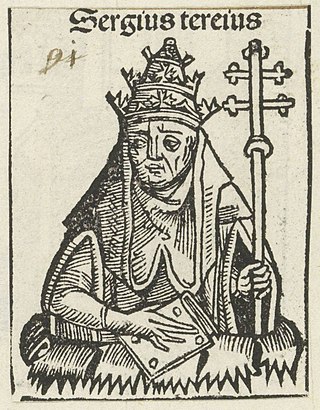
Pope Sergius III was the bishop of Rome and nominal ruler of the Papal States from 29 January 904 to his death. He was pope during a period of violence and disorder in central Italy, when warring aristocratic factions sought to use the material and military resources of the papacy. At the behest of Theophylact I of Tusculum, Sergius seized the papal throne from Antipope Christopher, who in turn had deposed Pope Leo V. Sergius' reign was subsequently marked by Theophylact's influence. As pope, Sergius continued many ecclesiastical controversies of his predecessors, including conflict over Pope Formosus' legacy, annulling all ordinations made by the late pope, and the filioque controversy with eastern patriarchs. His pontificate was similarly marked by temporal conflicts, with Sergius' refusal to crown Berengar I of Italy as Holy Roman Emperor, and his support of Byzantine Emperor Leo VI the Wise's fourth marriage. Sergius also saw the restoration of the Lateran Palace.
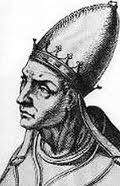
Pope Leo VIII was a Roman prelate who claimed the Holy See from 963 until 964 in opposition to John XII and Benedict V and again from 23 June 964 to his death. Today he is considered by the Catholic Church to have been an antipope during the first period and the legitimate Pope of Rome during the second. An appointee of Holy Roman Emperor Otto I, Leo VIII's pontificate occurred after the period known as the saeculum obscurum.
Pope Lucius II, born Gherardo Caccianemici dal Orso, was head of the Catholic Church and ruler of the Papal States from 9 March 1144 to his death in 1145. His pontificate was notable for the unrest in Rome associated with the Commune of Rome and its attempts to wrest control of the city from the papacy. He supported Empress Matilda's claim to England in the Anarchy, and had a tense relationship with King Roger II of Sicily.
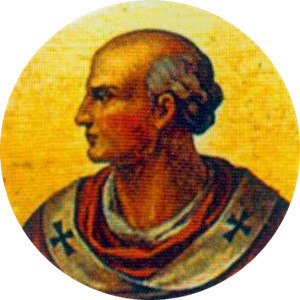
Benedict X, born Giovanni, was elected to succeed Pope Stephen IX on 5 April 1058, but was opposed by a rival faction that elected Nicholas II. He fled Rome on 24 January 1059 and is today generally regarded as an antipope.

Marozia, born Maria and also known as Mariuccia or Mariozza, was a Roman noblewoman who was the alleged mistress of Pope Sergius III and was given the unprecedented titles senatrix ("senatoress") and patricia of Rome by Pope John X.

Saeculum obscurum, also known as the Pornocracy or the Rule of the Harlots, was a period in the history of the Papacy during the first two-thirds of the 10th century, following the chaos after the death of Pope Formosus in 896 which saw seven or eight papal elections in as many years. It began with the installation of Pope Sergius III in 904 and lasted for sixty years until the death of Pope John XII in 964. During this period, the popes were influenced strongly by a powerful and allegedly corrupt aristocratic family, the Theophylacti, and their relatives and allies. The era is seen as one of the lowest points of the history of the Papal office.
Teobaldo Boccapecci or Boccapeconai, Latin: Thebaldus Buccapecuc) was elected pope after the death of Pope Callixtus II on 13 December 1124 and took the name Celestine II, but factional violence broke out during the investment ceremony and he resigned before being consecrated or enthroned in order to avoid schism.
GiordanoPierleoni was the son of the Consul Pier Leoni and therefore brother of Antipope Anacletus II and leader of the Commune of Rome which the people set up in 1143. According to Gregorovius, he was a “maverick” in the great Pierleoni family, for he continued to oppose the papacy after Anacletus' death, when the rest of his clan had returned to support of Rome.
Pier Leoni was the son of the Jewish convert Leo de Benedicto and founder of the great and important medieval Roman family of the Pierleoni. He was called the Jewish Crassus by Gregorovius.
The family of the Pierleoni, meaning "sons of Peter Leo", was a great Roman patrician clan of the Middle Ages, headquartered in a tower house in the quarter of Trastevere that was home to a larger number of Roman Jews. The heads of the family often bore the title consul Romanorum, or "Consul of the Romans," in the early days.
Oddone Frangipane was a Roman lord and military leader in the service of the Papacy in the 12th century.
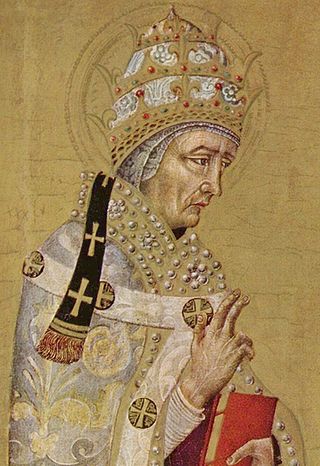
The selection of the pope, the bishop of Rome and supreme pontiff of the Roman Catholic Church, prior to the promulgation of In nomine Domini in 1059 varied throughout history. Popes were often appointed by their predecessors or by political rulers. While some kind of election often characterized the procedure, an election that included meaningful participation of the laity was rare, especially as the popes' claims to temporal power solidified into the Papal States. The practice of papal appointment during this period would later result in the jus exclusivae, i.e., a right to veto the selection that Catholic monarchs exercised into the twentieth century.
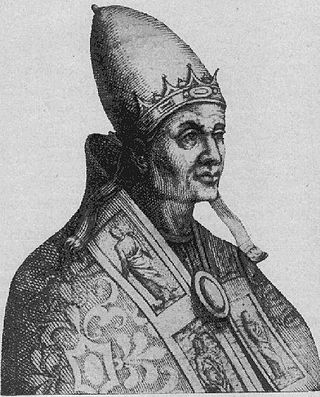
The Tusculan Papacy was a period of papal history from 1012 to 1048 where three successive relatives of the counts of Tusculum were installed as pope.
Giovanni Gaetano Orsini, Cardinal of the Holy Roman Church from 17 December 1316 until his death, was a Roman nobleman, a nephew of Pope Nicholas III and a grandson of Matteo Rosso Orsini.